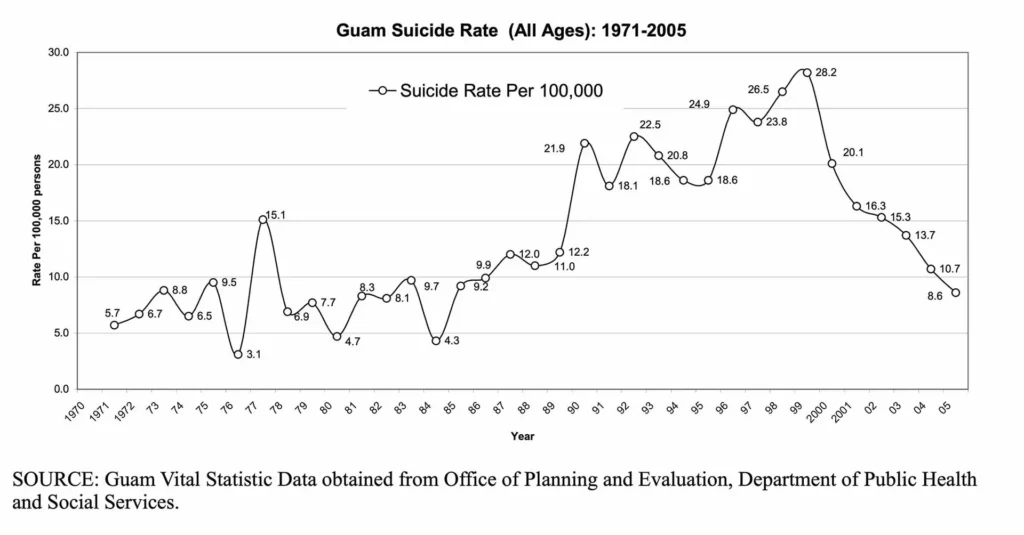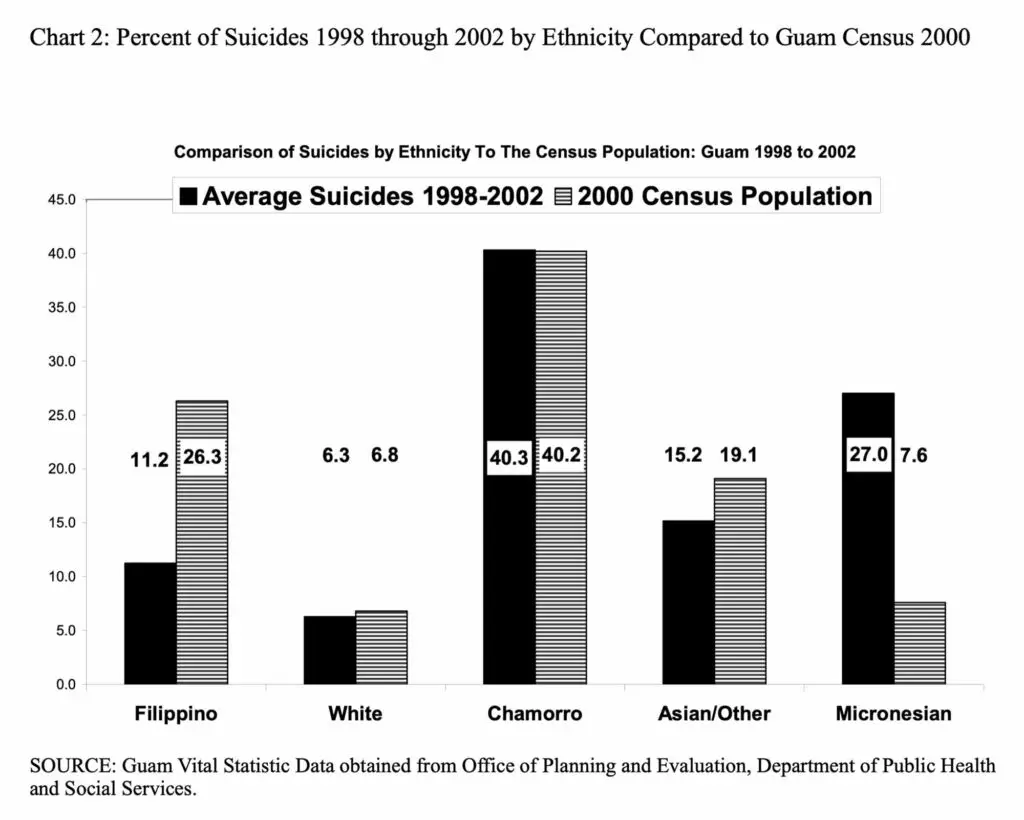Suicide in Micronesia
Table of Contents
Share This
Guam's historical trends and patterns
The historical record of suicide on Guam extends back to the mid-19th century. Father Aniceto Ibáñez del Carmen in his Chronicle of the Mariana Islands recorded 18 suicides between 1861 and 1891, or an annual rate of about 12 per 100,000. The romantic legend, Puntan dos Amantes or “Two Lovers’ Point,” alludes to the presence of suicide in CHamoru society.
According to the legend, a CHamoru couple leapt off a cliff to their deaths rather than submit to an arranged marriage that would have separated the two young lovers. While the legend cannot be dated exactly, its telling through the generations suggests that suicide was a part of CHamoru society, perhaps as far back as the pre-European contact period.
Looking at the history of suicide and the rates of suicide over the years among the general population provides a social cultural base line for Guam. Within all cultures, depending on circumstances, suicide has been either lauded as a selfless deed for the welfare of others or vilified as a tragedy. Yet suicide is publicly recognized as a social problem and denounced by all of the religions practiced on Guam today.
Mid-1960s saw increase
Within most of the Micronesian islands, rates of suicide increased sharply after the mid-1960s, becoming alarmingly high by the 1980s. At least on Guam, however, there has been a sharp decline after 2000.
Between 1955 and 1969, Guam averaged about four suicides a year, which was a rate of only six per 100,000, similar to rates in the rest of Micronesia and half the rate of the US during that period. The annual suicide rate on Guam was 7.5 per 100,000 persons from 1971 to 1980, and increased over the 1980s reaching 12.2 per 100,000 persons in 1990.
Meanwhile, suicide grew to epidemic proportions in the other islands of Micronesia. From the late 1970s up to 2000 the suicide rate in the Federated States of Micronesia (FSM), Palau, and the Marshall Islands has hovered between twenty-five and thirty per 100,000, giving the area one of the highest rates in the world.

Guam’s suicide rate shot upward in 1991 and hovered at high rates—similar to other Micronesian islands—throughout the decade, peaking at 28.2 per 100,000 in 1999. In the 1990s Pacific Islands rates were among the highest in the world. The highest rates were found in Fiji, the islands of Micronesia, Samoa, American Samoa, and by the end of the century, Guam.
By 2004, Guam’s rate had fallen to 10.7 per 100,000, and over the first six months of 2005 it had dropped further, to only only 8.6 per 100,000.
Since then, Guam’s suicide rate has again risen to 18 per 100,000. In contrast, the national mortality rate is 12 per 100,000. As of 2019, 130 people had committed suicide on Guam during the previous three years.
Differences by ethnicity, sex and age
Micronesians are considerably over-represented among Guam suicide cases as they account for 27 percent of Guam suicides, although they constitute only eight percent of Guam’s 2000 population. Filipinos, on the other hand, are underrepresented among the suicide cases; 11 percent of the total suicides are by Filipinos, who constitute fully one-fourth of Guam’s population. The number of suicides among CHamorus, Asian, and Caucasians on Guam are closely proportional to their populations.

On Guam, male suicides outnumber female suicides, which is a common pattern around the world. Between 1998 and 2000, Guam recorded five male suicide deaths for every female suicide (83.5 percent versus 16.5 percent, respectively). Males generally attempt suicide in ways more likely to result in death, whereas females typically employ less lethal methods.
Preferred methods
On Pacific Islands where female deaths outnumber males (e.g. Fiji), this is largely due to the lethality of the preferred method. In the Fijian islands, as in many other cultures, women typically use poison as a means of suicide, but the common poison in Fiji is paraquat, which is highly toxic and almost certain to cause death (an overdose of sleeping pills, in comparison, is not as lethal).
During the 1980s and 1990s the primary method of suicide in Guam was by hanging, accounting for a little more than half of the cases, and in 1999 all of Guam’s suicide deaths were by hanging. This is consistent with the most common methods in other islands of Micronesia.
A leading cause of death
The occurrence of suicide is highest among those 25-44 (about 47 percent of suicides between 2001-2005) and those 15-24 years of age (about 38 percent of suicides between 2001-2005). Records show no deaths attributed to suicide for youngsters under age 15 before 1973, but suicide among children has become a tragic island reality becoming about five percent of suicides between 2001-2005. This matches trends in other US places, which have also noted shifts with more suicides among those under age 15 years.
Within some island nations of the Pacific region, suicide is the leading cause of death for young adults, and youth rates are among the highest in the world. Most notable is Chuuk State in the FSM, Samoa, and Fiji, all with higher rates than Guam. Even so, on Guam in the 1990s, suicide was the second leading cause of death among youth aged 15-24 years of age.
As of 2019, suicide is the seventh leading cause of death on Guam.
Suicidal thoughts and behaviors
Indicators of suicidal thoughts and behaviors among Guam’s youth are relevant for designing suicide intervention and prevention programs. Although males have higher rates of death by suicide, females report higher frequencies of thinking about suicidal and actually attempting it. A national study found twelve and a half percent of Asian-American/Pacific Islander (AAPI) girls reported having attempted suicide compared to six and a half percent of AAPI boys.
Guam’s Youth Risk Behavior Survey shows the same pattern of high school aged girls being more prone to report suicidal tendencies (twenty-seven percent in 2003) than high school aged boys (only sixteen percent in 2003). Middle school students who reported having seriously considered suicide increased from thirty-one percent in 1999 to forty-one percent in 2003, and the percentage who reported having ever tried increased from fourteen percent to twenty-two percent.
Community awareness and development of professional programs can make a difference. In 2000, at the peak of Guam’s suicide epidemic, the community apparently benefited from the intense public discussion and frequent media news reports about the suicide problem. Continuing efforts to expand professional programs has increased the number of persons with suicide prevention counseling skills. These actions may account in part for the sharp drop in Guam’s suicide rate.
Resources
Some suicide warning signs include:
- Withdrawing from social contact and wanting to be left alone;
- Mood swings;
- Increased use of alcohol or drugs;
- Changes to normal routines, including eating or sleeping patterns;
- Giving away belongings or getting affairs in order without logical explanation for doing so.
For those in need of crisis assistance, the following numbers offer immediate help. All calls are confidential and free of charge.
- 24-hour Guam Crisis Helpline: 671 647-8833
- National Suicide Prevention Lifeline: 800-273-TALK (8255)
- 24-hour Guam Outreach Crisis Intervention for Youth: 671 475-7100
On Guam, the Guam Behavioral Health and Wellness Center also trains community members to learn more about and to better recognize the signs of suicide. Learn more at here.
For further reading
Booth, Heather. “Pacific Island Suicide in Comparative Perspective.” Journal of Biosocial Science 31, no. 4 (1999): 433-448.
Grunbaum, Jo A., Richard Lowry, Laura Kann, and Beth Pateman. “Prevalence of Health Risk Behaviors Among Asian American/Pacific Islander High School Students.” Journal of Adolescent Health 27, no. 5 (2000): 322-330.
Kachur, S. Patrick, Lloyd B. Potter, Stephen P. James, and Kenneth E. Powell. Suicide in the United States, 1980-1992. Violence Surveillance Summary Series, No. 1. Atlanta: Centers for Disease Control and Prevention, National Center for Injury Prevention and Control, 1995.
Workman, Randall L., Thomas K. Pinhey, Michael P. Perez, and Rachel T. Taitano. 1999 Safe & Drug Free Schools and Communities Study of Youth Risk Behaviors: Drug Use, Fighting and Health-Risk Behaviors Among Youth on Guam. Mangilao: Community Development Report, University of Guam, 1999.
